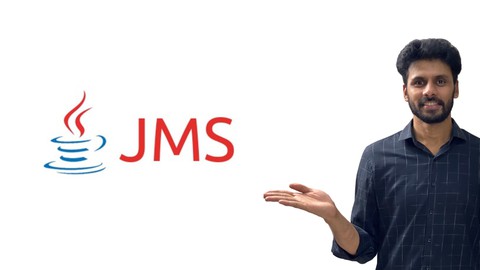
Java Message Service – JMS Fundamentals
Java Message Service – JMS Fundamentals, available at $89.99, has an average rating of 4.41, with 101 lectures, 9 quizzes, based on 2408 reviews, and has 13752 subscribers.
You will learn about Learn what messaging is and its advantages Understand the two different types of messaging Look at the anatomy of a JMS message Use JMS 1.X and 2.x APIs and learn the differences Use the JMS API to Implement point to point messaging Implement request-reply scenario Use the JMS API to Implement Publish-Subscribe messaging Work with durable and sharable subscribers Filter the message using properties and message headers See load balancing in action Learn asynchronous processing of messaging using Listeners Acknowledge message through different message acknowledgement modes Use JMS transactions to ensure message delivery Learn how to use JMS API in the Java EE context Deploy your JMS applications on a application server Use Spring Support for JMS All in simple steps This course is ideal for individuals who are Java Developers who want to master JMS or Java EE Developers who want to use Java Messaging Services or Students with Java background It is particularly useful for Java Developers who want to master JMS or Java EE Developers who want to use Java Messaging Services or Students with Java background.
Enroll now: Java Message Service – JMS Fundamentals
Summary
Title: Java Message Service – JMS Fundamentals
Price: $89.99
Average Rating: 4.41
Number of Lectures: 101
Number of Quizzes: 9
Number of Published Lectures: 101
Number of Published Quizzes: 9
Number of Curriculum Items: 114
Number of Published Curriculum Objects: 114
Original Price: $19.99
Quality Status: approved
Status: Live
What You Will Learn
- Learn what messaging is and its advantages
- Understand the two different types of messaging
- Look at the anatomy of a JMS message
- Use JMS 1.X and 2.x APIs and learn the differences
- Use the JMS API to Implement point to point messaging
- Implement request-reply scenario
- Use the JMS API to Implement Publish-Subscribe messaging
- Work with durable and sharable subscribers
- Filter the message using properties and message headers
- See load balancing in action
- Learn asynchronous processing of messaging using Listeners
- Acknowledge message through different message acknowledgement modes
- Use JMS transactions to ensure message delivery
- Learn how to use JMS API in the Java EE context
- Deploy your JMS applications on a application server
- Use Spring Support for JMS
- All in simple steps
Who Should Attend
- Java Developers who want to master JMS
- Java EE Developers who want to use Java Messaging Services
- Students with Java background
Target Audiences
- Java Developers who want to master JMS
- Java EE Developers who want to use Java Messaging Services
- Students with Java background
Sample of the reviews:
What a wonderful course by Bharat. He has explained every topic of JMS starting for basics and taking the journey to fully mastering the concepts using various quizzes and coding assignments. Totally recommend this course. Thanks a lot, for this course. You are a true mentor. – Amit Kumar
Yes. 110%. Bharath always delivers high-quality, succinct courses, with hands-on programming. – Maurice McFarlane
Very good overview of the Topic with enough detail that a developer can grasp the essentials quickly and make use of them immediately. Very well thought-out and presented. – Richard Kowalsky
—
Do you have the knowledge of Java want to master Java Messaging Service then this course is for you.If you are an experienced Java EE developer who wants to fill in any gaps in your knowledge of Messaging and know how messaging can be used to develop loosely coupled ,scalable and reliable applications then this course is for you too.You will explore both point-to-point and publish/subscribe models of messaging. You will also explore how synchronous and asynchronous messaging is accomplished. While the JMS API provides fundamental messaging support, you also explore Enterprise JavaBean’s Message Driven Bean (MDB).
JMS makes it super easy to create interoperable applications that communicate with each other using messaging. You will start this course by learning what Messaging is ,what JMS is and how to use the JMS API .You will be working hands on one feature at a time .You will
-
Learn what messaging is and its advantages
-
Understand the two different types of messaging
-
Look at the anatomy of a JMS message
-
Use JMS 1.X and 2.x APIs and learn the differences
-
Use the JMS API to Implement point to point messaging
-
Implement request-reply scenario
-
Use the JMS API to Implement Publish-Subscribe messaging
-
Work with durable and sharable subscribers
-
Filter the message using properties and message headers
-
See load balancing in action
-
Learn asynchronous processing of messaging using Listeners
-
Acknowledge message through different message acknowledgement modes
-
Use JMS transactions to ensure message delivery
-
Learn how to use JMS API in the Java EE context
-
Deploy your JMS applications on a application server
-
All in simple steps
Course Curriculum
Chapter 1: Start Here
Lecture 1: Course and Instructor Introduction
Lecture 2: How to make the best of this course
Chapter 2: Messaging Basics
Lecture 1: What is messaging
Lecture 2: Why Messaging
Lecture 3: What is JMS
Lecture 4: The two messaging models
Lecture 5: Apache ActiveMQ Artemis
Lecture 6: Download the completed projects
Lecture 7: Slides Used In the Course
Lecture 8: Assignment Solutions
Chapter 3: Software Setup
Lecture 1: Install Java 8 or Higher
Lecture 2: Install Spring Tool Suite
Lecture 3: Install Apache ActiveMQ Artemis
Lecture 4: Create the Messaging Broker
Chapter 4: Messaging in Action
Lecture 1: JMS 1.X API
Lecture 2: Create the project
Lecture 3: Configure JNDI properties
Lecture 4: Write a message to the Queue
Lecture 5: Consume a message from the Queue
Lecture 6: P2P in action
Lecture 7: Summary So Far
Lecture 8: Publish Subscribe in action
Lecture 9: Use QueueBrowser
Lecture 10: JMS 2.X
Lecture 11: JMS 2.0 is Cool
Chapter 5: Anatomy of a JMS Message
Lecture 1: Introduction
Lecture 2: Prioritize Messages
Lecture 3: Default Priority
Lecture 4: Request Reply Messaging
Lecture 5: Use replyTo JMS Header
Lecture 6: When to use replyTo header?
Lecture 7: Use MessageId and CorrelationId Headers
Lecture 8: Set message expiry
Lecture 9: Access Expired Message
Lecture 10: Delay the message delivery
Lecture 11: Add custom message properties
Lecture 12: Message Types
Lecture 13: Message types in action
Lecture 14: Create Object Message
Lecture 15: JMS 2.x makes it simple
Chapter 6: P2P Messaging
Lecture 1: When to use Point to Point
Lecture 2: Usecase
Lecture 3: Create the project
Lecture 4: Create the model class
Lecture 5: Create the clinical app and send a message
Lecture 6: Asynchronous Processing
Lecture 7: Receive Patient Data
Lecture 8: Check Eligibility and Send Reply
Lecture 9: Process the response
Lecture 10: Testing
Lecture 11: Load Balancing in action
Chapter 7: Pub- Sub Messaging
Lecture 1: When to use pub-sub
Lecture 2: Usecase
Lecture 3: Create the project
Lecture 4: Create the EventPublisher
Lecture 5: Create the Subscribers
Lecture 6: Pub Sub in action
Lecture 7: Durable Subscriptions
Lecture 8: Durable Subscriptions in action
Lecture 9: Shared Subscriptions in action
Chapter 8: Filter the messages
Lecture 1: Introduction
Lecture 2: Create the project and model
Lecture 3: Create the Claim Producer and Consumer
Lecture 4: Fliters in action
Lecture 5: Use other operators
Lecture 6: Filter by header
Chapter 9: Guaranteed Messaging
Lecture 1: Introduction
Lecture 2: Create the project
Lecture 3: Use AUTO_ACKNOWLEDGE
Lecture 4: DUPS_OK_ACKNOWLEDGE AND CLIENT_ACKNOWLEDGE
Lecture 5: Use CLIENT_ACKNOWLEDGE and DUPS_OK_ACKNOWLEDGE
Lecture 6: JMS Transactions
Lecture 7: JMS Transactions in action
Lecture 8: Transactions on the consumer side
Chapter 10: Security
Lecture 1: Introduction
Lecture 2: Create Users and Roles
Lecture 3: Configure Security
Lecture 4: Security in action
Chapter 11: Message Grouping
Instructors
-
Bharath Thippireddy
IT Architect and Best Selling Instructor- 700000+ students
Rating Distribution
- 1 stars: 14 votes
- 2 stars: 38 votes
- 3 stars: 230 votes
- 4 stars: 983 votes
- 5 stars: 1143 votes
Frequently Asked Questions
How long do I have access to the course materials?
You can view and review the lecture materials indefinitely, like an on-demand channel.
Can I take my courses with me wherever I go?
Definitely! If you have an internet connection, courses on Udemy are available on any device at any time. If you don’t have an internet connection, some instructors also let their students download course lectures. That’s up to the instructor though, so make sure you get on their good side!
You may also like
- Best Investing Courses to Learn in March 2025
- Best Personal Finance Courses to Learn in March 2025
- Best Health And Wellness Courses to Learn in March 2025
- Best Chatgpt And Ai Tools Courses to Learn in March 2025
- Best Virtual Reality Courses to Learn in March 2025
- Best Augmented Reality Courses to Learn in March 2025
- Best Blockchain Development Courses to Learn in March 2025
- Best Unity Game Development Courses to Learn in March 2025
- Best Artificial Intelligence Courses to Learn in March 2025
- Best Flutter Development Courses to Learn in March 2025
- Best Docker Kubernetes Courses to Learn in March 2025
- Best Business Analytics Courses to Learn in March 2025
- Best Excel Vba Courses to Learn in March 2025
- Best Devops Courses to Learn in March 2025
- Best Angular Courses to Learn in March 2025
- Best Node Js Development Courses to Learn in March 2025
- Best React Js Courses to Learn in March 2025
- Best Cyber Security Courses to Learn in March 2025
- Best Machine Learning Courses to Learn in March 2025
- Best Ethical Hacking Courses to Learn in March 2025






















